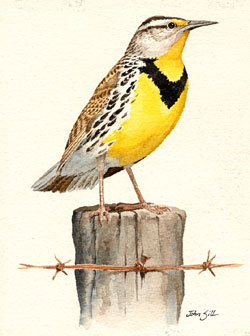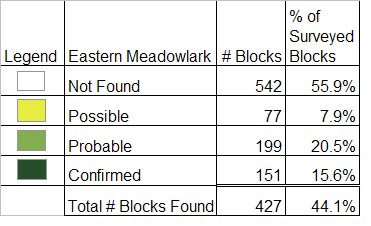Breeding Bird Atlases (BBA)
Find a Bird - BBA1
Breeding Bird Atlas 1 Species Accounts
Eastern Meadowlark
Sturnella magna
Egg Dates
May 5 to July 4
Number of Broods
one

Formerly common throughout Massachusetts and particularly abundant in hay fields and salt marshes along the coast, the Eastern Meadowlark is presently on the decline here due to reforestation and the consequent dwindling of its open-country habitat. This trend can be seen as no more than a return to the probable status that meadowlarks occupied in Massachusetts for thousands of years before European settlement, namely as local residents of coastal meadows and forest clearings that were maintained with fire by Native Americans. The mid-1800s, when 75 percent of the Commonwealth was tilled or grazed, appeared as a brief and aberrant golden age for meadowlarks and other field-inhabiting creatures. Presently, we seem to be in an equally extreme “de-pastoralization” process; someday the state’s landscape may consist solely of forests, suburbs, and cities. Meadows will be few and far between.
As the map indicates, the species is presently far from rare, but over much of its range it has withdrawn into isolated local populations and retains real strongholds only in the Connecticut River valley, eastern Berkshire County, and the Middleboro-Bridgewater area in southeastern Massachusetts. On Cape Cod, where it was once abundant and widely hunted as “Marsh Quail,” it is now very local.
In spring, migrant meadowlarks are seen in largest numbers from mid-March to mid-April. Males arrive two weeks before females and establish a territory averaging about 7 acres. As with other open-country birds, male meadowlarks give territorial and courtship songs from fence posts, telephone poles, or high points of vegetation within or at the margins of their territory. The song is a somewhat variable, rather twangy three- to five-note whistle rendered variously as tsee-you tess-can or heetar-su-e-oo. When the females arrive, display intensifies and includes a seldom-heard flight song that has been described as bobolinklike but less hurried. There are also a number of harsh calls including chatters, shrill whistles, and nighthawklike beeps. Male meadowlarks may mate with more than one female. Parasitism by cowbirds is apparently relatively uncommon.
Within their generalized habitat preference, meadowlarks will tolerate considerable variation from actively cultivated grain, hay, and cornfields to abandoned fields with scattered shrubs, revegetated, capped landfills, and (rarely) old orchards underlain with grasses and weeds. The nest is a rather large structure made of coarse grasses and weed stems. Over the cup, which is formed on the ground, typically in a depression (e.g., a hoofprint), the birds usually construct a dome or canopy that is woven into the surrounding grass stems. The lining is of finer grass and sometimes animal hairs. As the birds come and go, one or more tunnels are often formed leading from the nest entrance out through the dense surrounding grasses. A nest in Chatham was built in Dunegrass and sunk into the sand (ACB). Finding a meadowlark’s nest is a distinct challenge because parent birds will often land a hundred yards or more from the site and then walk in along an invisible route. The two to seven (often five) eggs are white (rarely pinkish or greenish) and finely speckled to coarsely splotched (rarely unmarked) with brownish, reddish, or purplish markings. Clutch sizes for 5 state nests were four eggs (1 nest), five eggs (4 nests) (ACB, DKW, CNR). The eggs are incubated by the female alone for 13 to 14 days (sometimes slightly longer). The young are alert and feathering at 8 days and leave the nest 11 to 12 days after hatching. They are fed for two weeks or more after fledging.
Nestlings have been observed in Massachusetts from May 17 to June 2, and fledglings have been seen from June 6 to July 18 (BOEM, CNR, Meservey). One nest held four young on May 17 (BOEM), and four young fledged from another nest about June 4 (CNR). It is believed that a single brood is reared each year in our area.
In fall, meadowlarks congregate in loose flocks in salt marshes and other open areas along the coast, with smaller numbers present in inland meadows. Migrating flocks are observed chiefly in October. Meadowlarks winter regularly in Massachusetts in variable numbers, probably surviving only the mildest winters inland but regularly occurring in small numbers locally along the coast. Most winter to the south.
Map Legend and Data Summary
Atlas 1 data collected from 1975-1979


Note: uncommon in fields, meadows, and grasslands throughout most of the state
Christopher W. Leahy



